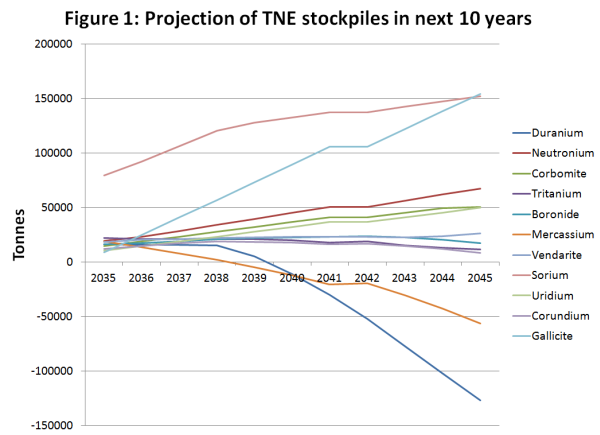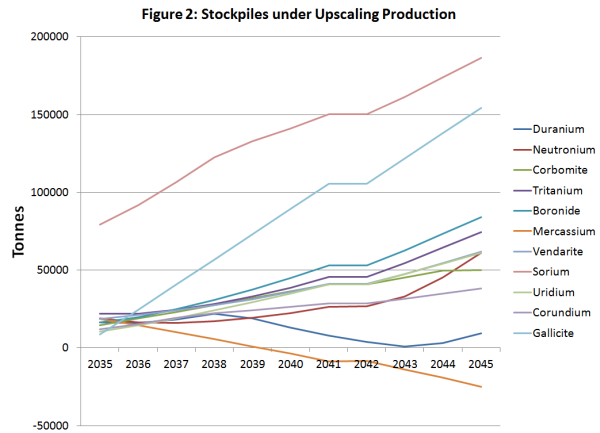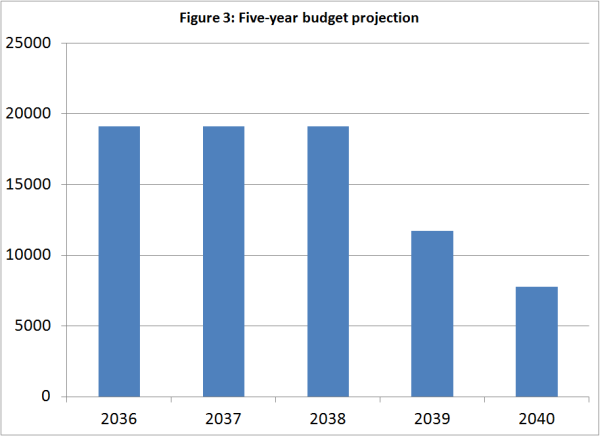Duranium Options Paper
by Aethernet
published in November 2035
Contents
Overview
UNEC, much like the governments of the early 21st century, faces a slow-burning resource crisis. Two of the TNEs vital to our newly interstellar civilisation are rapidly running out on our home world, and unlike our forebears we cannot rely on radical new mining techniques to make previously uneconomic deposits viable, as the sheer value of these elements already means that extraction of every atom is worthwhile, no matter the financial cost. There will be no equivalent of fracking for Duranium. At our current consumption rates, our supplies of these minerals will be exhausted in less than half a decade.
While both elements are valuable, Duranium is instrumental in very nearly every activity the UN undertakes – shipping, construction, mining and research. Without it our current economic expansion rate will significantly reduce. Several sources of the element are available within our solar system, and this paper sets out options for extracting new or managing existing Duranium supplies in order to supply the needs of our economy in the decades to come. While UNRL’s mission is to secure mineral supplies, many of the actions required to do so fall under the heading of other UNEC departments, and this paper is intended to kick-start discussion towards an eventual consensus.
Duranium Extraction
Under the UN’s current approach to extraction, TNEs can be acquired and made ready for use in the following ways:
- - Manned mines
- - Automated mines
- - Non-TNE mining facilities
Hypothetically, TNE extraction devices could be placed on a space-based vessel and used on objects with very low mass – asteroids, in the main. However, the UN currently has no plans to develop this facility. Each approach carries with it costs and benefits – manned mines are cheaper, but require life support and other infrastructure to be operated in non-terrestrial environments, while automated mines require twice the minerals of manned. Conventional mining facilities are inefficient, but can be converted to manned mines more cheaply than any other option. If our aim is to maximise Duranium production, we should deploy extraction facilities that provide the best return on investment.
Based on our understanding of colonial economics, the amount of infrastructure required to support mine workers can vary considerably and not necessarily in a linear fashion. Table 1 has been prepared to illustrate how we project populations to develop under certain environmental conditions, and the relative costs of mining infrastructure:
Note: Mineral costs are given as over and above the costs of manned mines, so the cost of deploying a manned mine is the infrastructure required to support sufficient population to man it, while the automated mine cost is given as the cost of the automine minus the cost of the mine, whether that mine is built using existing industry ('vs CI') or from scratch.
More hostile environments require more workers committed to keeping a colony going, as one would expect. However, as population increases, employment in service industries grows ever more lucrative, meaning proportionately more workers are employed in the sector rather than manufacturing. Note that a colony with a cost on the Environmental Support Scale of 2 does not support three times as many mines as a similar colony with a third of the infrastructure - the increase is in fact only 80%. This important factor in colonial economics dictates that there is a breakeven point for every colony when automated mining represents a better ROI than manned mines plus infrastructure. Both Tranquillity and Calisto are beyond this point, although terraforming offers the possibility of changing this situation. We understand there has been some discussion within the General Assembly about the economics of using orbital habitations to run on-planet infrastructure. While the technology to support this has not been developed, we anticipate that indicative costs for this approach can be developed by multiplying the Duranium cost for automated mines given above by a factor of approximately 3.
Option 1 – Upscaling Production
This first option has been developed using UNRL’s in-house economic model with a view to maintaining Duranium production levels in order to permit the UN to continue spending it at the current rate. Doing so requires a modal shift in our current economic strategy: Reducing planned new construction facilities to a level that will replace lost production from upgraded conventional industry. UNRL estimates this to be around 140 facilities. If our current consumption rate is unsustainable, increasing that rate will simply mean that we run out of minerals more quickly without providing any additional benefit. This policy should be re-opened once mineral production is on a sustainable footing. UNEC, and in particular UNIEB, should consider this recommendation even if Option 1 is not selected.
Radically reordering Tranquillity’s industry. While adding new infrastructure to support miners to Luna represents a loss compared to automated mining, the existing infrastructure is a sunk cost and should be taken advantage of. However, given that terraforming increases the number of workers (and hence mines that can be staffed) a given amount of infrastructure can support, it should be continued. UNRL estimates that, if the currently under construction terraformer is completed, the two outstanding terraformers transferred to Earth’s production queue, the construction, ordnance & fighter factories are mothballed or shipped to Earth and the terraformers on Earth are shipped to Luna, the colony could support 15 terraformers and 250 manned mines. These mines, representing an addition of 179 to Tranquillity’s current total, should be produced from conventional industry on Earth within a year and shipped to Luna. Luna’s mass drivers are to be directed at Earth.
Allocating 40% of our construction capacity to the production of automated mines, for an initial run of 1,000. These mines should be immediately shipped to Luna on production. While transferring them to Callisto would permit them to access its Mercassium deposits, this would result in lower output as a result of the increased travel time. Our modelling projects the following impact of this plan on Earth’s mineral stockpiles, holding all other elements of consumption constant:
Following this ten-year period, it is likely that the automines will need to be transferred to Callisto as Luna will be approaching exhaustion. By this period UNRL anticipates faster engines will reduce the lost production caused by transit times.
Option 2 – Duranium Budgeting
In the event that the level of structural change Option 1 represents is unpalatable to UNEC, the alternative mineral management option is for UNRL to set a yearly budget for Duranium consumption based on projected output and for UNEC to come to a consensus on projects that together fall under that budget. Indicative figures for this budget are as follows:
It is likely that Option 1 will require a measure of budgetary control in any case, in the event that consumption is higher than projected. However, the budgetary constraints should be considerably higher owing to increased production. Please note that demand for shipyards alone represents nearly 5,000 tonnes per year.
Option 3 – Do nothing
This option is always available to policymakers. In the event that UNEC is unable to come to an agreement on this issue, UNRL cannot guarantee that minerals will be available for agreed projects.
The above options are not exhaustive and have a range of iterations which UNEC can discuss, and UNRL anticipates that the most likely outcome is some mix of 1 and 2. However, given the nature of this problem early agreement is preferable in order to head off a damaging economic slowdown.



